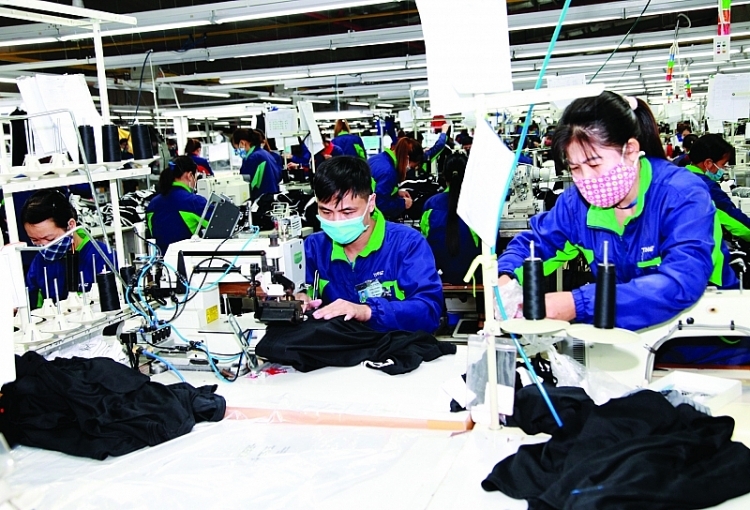VCN – In order to narrow the gap between Vietnam and developed countries, besides maintaining a much higher export-to-GDP ratio than other countries, Vietnam needs to solve the problem of importing many high-quality input products for export.
 |
| The recent increase in labor productivity is mainly due to enhancing investment capital and low-cost labor. Photo: Xuan Thao. |
Transforming the growth model is still slow
Speaking at the Workshop “Converting growth models, restructuring the economy: 35 years of experience in innovation” held on April 26, Mr. Nguyen Duc Hien, Deputy Head of the Central Economic Commission said that practical assessment of the implementation process of guidelines and policies related to growth model innovation and economic restructuring showed clear results such as macroeconomics had been stabilized, economic growth achieved important results, the economic growth rate reached a good level, the growth model was gradually transformed in the direction of width and depth; the quality of growth gradually improved, although it was still at a modest level.
In addition, labor productivity, total productivity and national competitiveness had been improved, and the economic structure shifted in a more positive direction. The structure of industries and fields changed in the direction of improving the competitiveness of a number of industries and fields where Vietnam had advantages in participating in regional and global value chains.
“The key issues of economic restructuring, including restructuring public investment, state-owned enterprises and credit institutions have focused on implementing and achieving some initial results. Restructuring the state budget and the public sector has achieved some remarkable results,” said Mr. Nguyen Duc Hien.
However, according to Mr. Nguyen Duc Hien, transforming the growth model in depth is still slower than required. The growth model is still mainly based on input factors including capital, labor and resources. The contribution of total factor productivity (TFP) to economic growth is still limited, much lower than that of other countries in the region at the same development stage.
The recent increase in labor productivity is mainly due to increased investment capital and low-cost labor. Capital is still mainly based on labor-intensive economic activity. To a certain extent, it still relies on exports and increasing foreign investment increasingly. Labor productivity is still low and the gap between Vietnam’s labor productivity and other countries continues to widen.
Restructuring the economic sector according to regional advantages
The issues of restructuring the three key areas, although implemented more substantively, have not yet accomplished many of the goals set out as planned.
Public investment efficiency is not high and disbursement of public investment capital is slow, especially ODA. The process of equitizing state-owned enterprises and state capital in enterprises is still slow compared to the plan, mainly focusing on reducing the quantity and quality of corporate governance, which has not been improved. The production and business efficiency of many state-owned enterprises is still low.
In addition, the progress of bad debt settlement of credit institutions still faces many difficulties. The process of restructuring the state budget and public service units is still limited. The transition process of economic restructuring, as well as industry and field restructuring is still slow. The private sector is still not strong enough to meet the important role of the economy. The institution of a market economy and socialist orientation still has many problems that need to be solved.
Dr. Dang Kim Son, former director of the Institute of Policy and Strategy for Agriculture and Rural Development, analyzed the problems posed in the process of transforming the growth model and restructuring the economy. At the same time, some orientations are proposed such as the role of the macro environment to be ready for innovation; restructuring the economic sector according to regional advantages; restructuring cities towards decentralization and cohesion; restructuring enterprises and economic organizations and restructuring the resource market in a healthy way to catch up with countries in the region and the world.
Also according to Dr. Jonathan Pincus, Senior Economic Advisor (UNDP), to narrow the gap between Vietnam and developed countries, besides maintaining a much higher export-to-GDP ratio than other countries. Vietnam needs to solve the problem of importing many high-quality input products for export. On the other hand, most of Vietnam’s private enterprises are very small; large private enterprises are not processing enterprises but real estate enterprises through land speculation.
“It is necessary to create a mechanism and equal playing field for domestic and FDI enterprises, in which special attention is paid to the financial mechanism for small and medium enterprises, especially micro enterprises. In addition, Vietnam needs to better transform from the stage of strategy and planning to the implementation of strategies and plans through reducing the fragmentation of power in the implementation process,” said Dr. Jonathan Pincus.
By Xuan Thao/ Binh Minh
